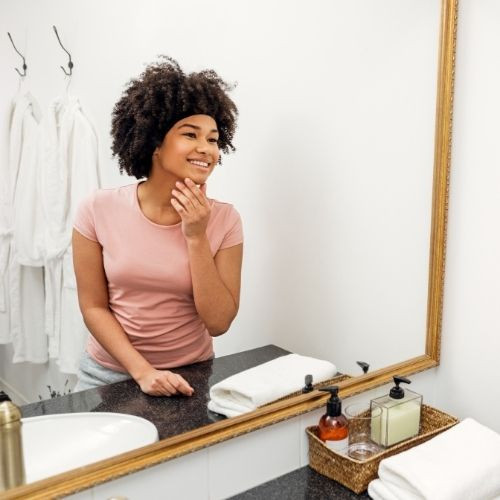What's That Dark Spot? Causes and How to Treat Them
Posted by Nikki Wisher on Jun 28th 2021
There you are, living your life, minding your own business, when you look in the mirror and suddenly see a brown spot on your skin that you swear you’ve never seen before. What is the unwanted intruder, where did it come from, and most importantly, what can you do about it?
We all want that complexion that’s so even and smooth it looks like we’re wearing a full face of foundation, but unwanted spots happen. Before you can get rid of your new uninvited guest, the first step is figuring out exactly what it is. Take a look at these common types of brown spots see which one sounds like your intruder.
Age Spot
These go by many names: age spots, sunspots, liver spots, and in clinical settings, solar lentigines. Whatever you call them, though, age spots all come from the same cause – and it isn’t aging.
These spots form as the result of accumulated sun damage throughout your life. They’re usually associated with aging because it often takes until your 40s or 50s to build up enough sun damage to create them, but they’re not an inevitable part of aging.
Age spots can vary in size, but they look like slightly darker dots or patches of skin. They’re usually not perfectly round, but more irregularly shaped. They’re also flat and untextured.
What can you do about age spots? Try a skin brightener which is designed to reduce excess pigment in age spots.
Scar
When most people think of scars, they think of the scar tissue that forms after a cut or injury. Scars can come in multiple forms, though, and one type actually looks like a brown spot. It comes from a process called post-inflammatory hyperpigmentation.
When you have intense inflammation like the inflammation that comes from acne, your body may produce extra melanin, or skin pigment, as it’s trying to heal the inflammation. When the inflammation fades, you’re left with a spot of extra pigment. So, if you’ve recently had acne (or just a single tricky pimple) and you’re seeing a new brown spot in that area, it could be an acne scar.
What can you do about a pigmented scar? Fortunately, there are products like Murad Invisiscar Resurfacing Treatment, which is designed to smooth and reduce acne scars.
Freckle
Most people have at least a few freckles, so you’re probably familiar with what they look like: flat, circular brown spots that vary in size and darkness. Even if you have your brown spot pegged as a freckle, it can be surprising to see a new freckle because most of our freckles stay the same throughout our lives. What gives?
New freckles can actually pop up at any time, and they appear because of sun exposure. They’re similar to age spots, in truth, but think of new freckles as a precursor to age spots.
New freckles are harmless in and of themselves, but they do send you the message that you’ve been getting too much sun exposure. It’s time to incorporate a daily reef-safe sunscreen into your morning routine. Don’t forget to also reapply your sunscreen any time you’re heading outside for more than an hour or two.
Mole
Moles and freckles have a lot in common. They’re both so common that almost all of us have at least one of them. They both also tend to stay the same throughout our lives, though some small variation is possible. They even look similar, though moles are often darker and are raised above the skin while freckles are flat.
There is one difference, though: if a new mole appears (or if you see changes in an existing mole), it could be a sign of melanoma skin cancer. If this happens, it’s always best to visit your dermatologist so they can examine the change and find out if it’s a cause for concern. Chances are that everything is fine, but ignoring it isn’t a risk worth taking.
Melasma
Melasma is probably the least-known of all these types of brown spots among the general public. And in fact, it’s less common than the other types of brown spots on this list too.
Melasma looks a lot like large age spots on your face: it appears as slightly darker patches than your natural skin, but it’s often across larger areas of the forehead or cheeks. It’s the result of excess pigment in your skin, but in this case, that excess pigment is caused by hormonal changes. An important note, though: sun exposure often plays a role too, so in many cases, melasma develops because of a combination of hormones and sun damage.
Melasma most often appears in women during pregnancy, which is why it’s sometimes called a pregnancy mask. There are plenty of shifts in hormones that can cause melasma, though, so don’t assume that it isn’t melasma because you aren’t pregnant. Melasma can happen in people of any sex.
What can you do about melasma? Fortunately, it often goes away when your hormones get back on track. If you’re pregnant, your melasma will likely go away not long after you give birth. If you understandably don’t want to wait until that happens, though, a melanin-correcting product like Dermaceutic Mela Cream is a handy tool.
Tackling Your Brown Spots and Skin Changes
Everyone’s skin changes as we get older – it’s just a fact of life that we all have to face. There’s only so much you can do about changes like wrinkles and sagging, but when it comes to most brown spots, you have more preventative power than you think.
A common thread for all of the brown spots above is sun exposure, so start using sunscreen as part of your daily morning routine right now. Chances are that you can keep future spots to a minimum, and that alone is worth the effort.

